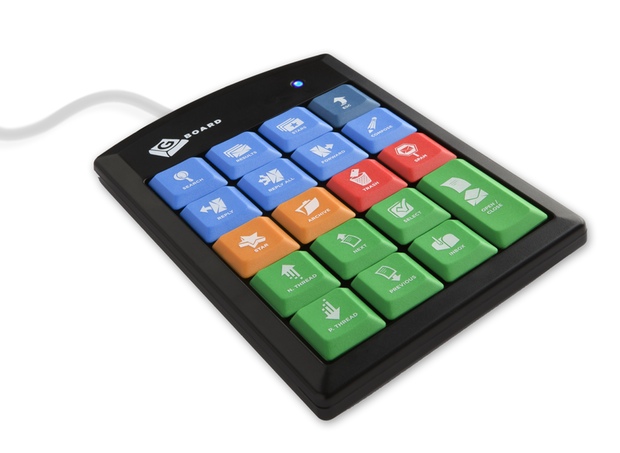
Short Version: The GBoard costs $19.99. It’s a USB keypad that has nineteen specially labeled keys for specific GMail actions: search, reply, reply all, star, archive, etc. The back of the unit has an adjustable lever so you can change the angle of the keypad. I’m left wondering what problem this accessory solves.
Review:
Keyboards and mice are horribly inefficient means for interacting with computers. They each suck in their own way, but they’re even worse together. I cringe every time I see someone type in a username and password: type username using the keyboard, use the mouse to click into password field, type in password using the keyboard, and then use the mouse to click the “Submit” button. It seems that people don’t know how the TAB and RETURN keys work.
All that moving back and forth between input devices is slow, and error prone. Using a single input device is much, much more efficient (just watch an expert do anything in Vim or emacs sometime!). Did you know that many of the Google services we’ve all come to know and love have keyboard shortcuts to make using only a keyboard more practical? There are keyboard shortcuts for Google Mail and Google Reader, but I suspect that the “average user” is going to have a hard time remembering these. Enter the GBoard, the keyboard for GMail.
Let me say this again: this is a keypad with buttons to do things that you can do using your normal keyboard. Take a look again at the GMail keyboard shortcuts, and then look at the photo above. Here’s the result of pressing each of the GBoard keys in a plain text editor:
/ u gs
r a f c
s e # !
k p x
j n gi
Not shown above are the results for pressing Escape or Open/Close, which correspond to the actual Escape key, and the return key.
There’s no ability to tweak the arrangement of the keys on the GBoard. If you don’t like the placement of the Compose button, you’re out of luck. You’ll need to move your hand over to your mouse and then move the mouse pointer over to the “Compose” link. Or, you know, you could just press the “C” key on your keyboard.
You still need to move your hand from your normal keyboard over to the GBoard, so the time savings of using keyboard shortcuts is partially nullified. I suppose if you want to learn to use keyboard shortcuts, but just can’t get them to stick in your noggin, the GBoard could be a helpful stepping stone. Or you could just print out the list of keyboard shortcuts and tape them to your monitor.
Product Page: GBoard.com